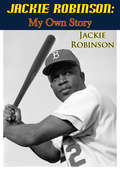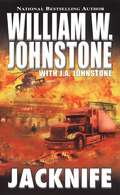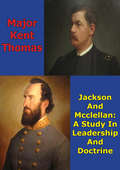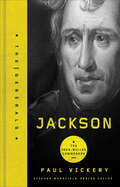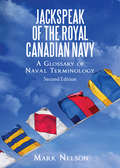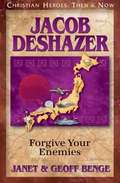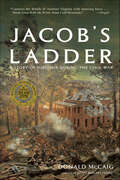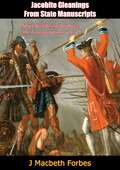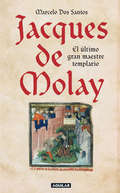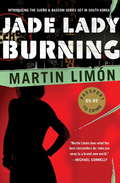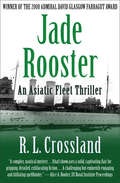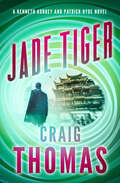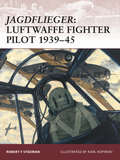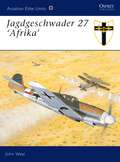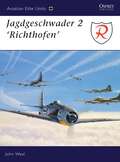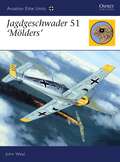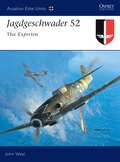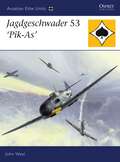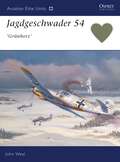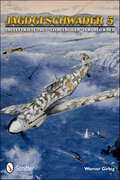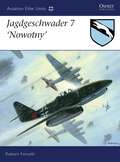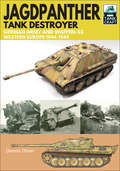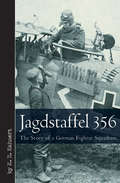- Table View
- List View
Jackass Flats (Riding Cowboy Flats #1)
by Julia Talbot2nd EditionCan a traveling military man and a set-in-his-ways cowboy find a way to make things work? Tate feels like the best part of life has probably passed him by, which is why the thirtysomething cowboy hits the bars every night. When he meets Dave, a young soldier from a nearby Army base, though, Tate figures things might be looking up. He and Dave get off to a rocky start, but Tate soon finds that he and the kid have enough in common to make things interesting. Dave isn't really into the whole don't ask, don't tell thing, and he doesn't bother to hide his relationship with Tate from his friends. Once he realizes he should have been more careful, it might be too late. But Dave is willing to fight for Tate, even if it means taking on the military.First Edition published by Torquere Press, 2008.
Jackie Robinson: My Own Story
by Jackie Robinson Branch Rickey Wendell SmithAutobiography of baseball legend Jackie Robinson, beginning with his athletic career and dealing particularly with baseball and the first step toward equal participation by African Americans in this great sport."I believe that a man's race, color, and religion should never constitute a handicap. The denial to anyone, anywhere, any time of equality of opportunity to work is incomprehensible to me. Moreover, I believe that the American public is not as concerned with a first baseman's pigmentation as it is with the power of his swing, the dexterity of his slide, the gracefulness of his fielding, or the speed of his legs."--From Foreword by Branch Hickey
Jackknife (Black Ops #3)
by William W. Johnstone J.A. JohnstoneOnly one man can stop a Black Friday terrorist strike in this pulse-pounding and timely thriller from the national bestselling author of American Jihad. America Is Under Attack And this time, it&’s not New York City or Washington. A sleeper cell of Middle Eastern terrorists is targeting the heartland: an all-American superstore on opening day, right outside of Fort Worth, Texas. The day after Thanksgiving. As insurance, the terrorists have also hidden a suitcase nuke somewhere in the store which they plan to detonate—a strike fifty times worse than 9/11 that will paralyze America. A Plot to Cripple the Country A lone American intelligence agent uncovers the plot after a raid on a terrorist training camp in Pakistan. But he&’s up against the inept bureaucracy of Homeland Security and the State Department—who refuse to listen . . . and now it&’s too late. They Call Him Jacknife The only thing stopping the kill-crazy terrorists is already inside the superstore—a truck-driving, former Special Forces op named John &“Jacknife&” McCabe. He&’s where the perfect terror plan is about to blow apart. Because Jacknife won&’t go down without a fight. And with this guy as leader, the terrorists will find their way to paradise a lot sooner than they think . . .
Jackson And McClellan: A Study In Leadership And Doctrine
by Major Kent ThomasCentral to the waging of war at the tactical level is the interplay between leadership and doctrine. Within a doctrinal context, the Army must develop leaders capable of winning the next war. This study examines the balance between leadership and doctrine and identifies the characteristics that distinguish the great leader from the also-ran.The vehicle for this examination is a comparison of two American Civil war generals, Stonewall Jackson and George McClellan. Purporting to support the same doctrine, the two men achieved remarkably dissimilar results on the battlefield. This analysis demonstrates that the reasons for that difference lay primarily in the realm of leadership rather than in the implementation of doctrine, and identifies the leadership principles key to success at the tactical level of war.
Jackson: The Iron-Willed Commander (The Generals Series)
by Paul VickeryA gripping account of the man who emerged as a national hero through his military successes—and became the seventh President of the United States.Orphan. Frontiersman. President. The rise of Andrew Jackson to the highest office in America has become a legend of leadership, perseverance, and ambition. Central to Jackson’s historic climb—long before the White House—was his military service. Scarred permanently as a child by the sword of a British soldier, Jackson grew into an unwavering leader, a general whose charisma and sheer force of personality called to mind those of George Washington a generation earlier.As commander of the Tennessee militia in the War of 1812, Jackson became “Old Hickory,” the indomitable spearhead in a series of bloody conflicts with the Creek on the southwest frontier. Slight of frame with silver hair that seemed to stand on command, Jackson once stood down a mutinous brigade as an army of one. Then came New Orleans. Author Paul Vickery chronicles Jackson’s defining battle and the decisions a single, impassioned commander made to ensure a growing nation could, once and for all, be free of British might. The hero of New Orleans infused America, for the first time, with a sense of nationalism.Jackson was decisive and unforgiving, a commander firmly in his element. In his own words, “One man with courage makes a majority.” The lessons of one extraordinary general endure.
Jackspeak of the Royal Canadian Navy: A Glossary of Naval Terminology
by Mark NelsonPull up a bollard and get to know the colourful language of the Royal Canadian Navy. Do you ever get channel fever so bad only a great homeward bounders will cure you? Have you ever met Tug Wilson the brass-pounder, Dusty Miller the blanket stacker, or Nobby Clark the stoker? From aback to zizEX, the second edition of Jackspeak of the Royal Canadian Navy gives readers a chance to fill their boots with the colourful language of Canada’s senior service. Learn the difference between duff and no duff, box kickers and gut robbers, and Nelson’s blood and Neptune’s dandruff. Newly revised and expanded, with over 2,500 terms included!
Jacob Deshazer: Forgive Your Enemies (Christian Heroes Then & Now)
by Janet Benge Geoff BengeThree thousand feet above China, it was Jake's turn to jump. He slid his pistol, knife, and ration packets into the pockets of his leather jacket and edged toward the open hatch of the B-52 bomber. He checked the tension on the harness of his parachute, made sure the handle of the ripcord was free, and then began lowering himself out of the hatch and into the darkness. One of the famous Doolittle Raiders who first attacked Japan after the bombing of Pearl Harbor, Jacob DeShazer knew this one-way mission was dangerous. Indeed, it led to his capture as a prisoner of war. Beaten, malnourished, and alone in his cell, Jacob was given a Bible - and far away from home, this American soldier became a Christian. After the war, Jacob returned to Japan and served his former enemy for thirty years as a missionary. His testimony of forgiveness and reconciliation - of love over hate - inspires a powerful gospel message for our lives today.
Jacob's Ladder: A Story of Virginia During the War
by Donald McCaigWinner of the Michael Shaara Award for Excellence in Civil War Fiction A civil war saga that resonates with the bitter glory and human shame of the Confederacy.Jacob’s Ladder is a Civil War epic, a love story that pits the indomitable longing of the human heart against circumstances of racism, slavery, and war. Duncan Gatewood, seventeen and heir to the Gatewood plantation, falls in love with Maggie, a mulatto slave, who conceives a son, Jacob. Maggie and Jacob are sold south, and Duncan is packed off to the Virginia Military Institute. As Duncan fights for Robert E. Lee, Jesse—a Gatewood slave whose love for Maggie is unrequited—escapes north and enlists in Lincoln’s army, determined to confront his former masters, while Maggie finds herself living a life she never could have imagined as the wife of a blockade runner.From the interlocked lives of masters and slaves, Donald McCaig conjures a passionate and richly textured story in the heart of America’s greatest war. The destiny of these three compelling characters connect a Vicksburg brothel to a Richmond salon, the nightmare of a Confederate hospital to the lurid hell of battlefields at Fredericksburg and Chancellorsville.Winner of the John Eston Cook Award Winner of the Boyd Military Novel Award
Jacobite Gleanings from State Manuscripts: Short Sketches Of Jacobites; The Transportations In 1745 (classic Reprint)
by J Macbeth ForbesThe Jacobite rising of 1745, also known as the Forty-five Rebellion or simply the '45, was an attempt by Charles Edward Stuart to regain the British throne for his father, James Francis Edward Stuart.Charles launched the rebellion on 19 August 1745 at Glenfinnan in the Scottish Highlands, capturing Edinburgh and winning the Battle of Prestonpans in September. At a council in October, the Scots agreed to invade England after Charles assured them of substantial support from English Jacobites and a simultaneous French landing in Southern England. On that basis, the Jacobite army entered England in early November, reaching Derby on 4 December, where they decided to turn back.Similar discussions had taken place at Carlisle, Preston and Manchester and many felt they had gone too far already. The invasion route had been selected to cross areas considered strongly Jacobite but the promised English support failed to materialise; they were now outnumbered and in danger of having their retreat cut off. The decision was supported by the vast majority but caused an irretrievable split between Charles and his Scots supporters. Despite victory at Falkirk Muir in January 1746, the Battle of Culloden in April ended the Rebellion and significant backing for the Stuart cause. Charles escaped to France, but was unable to win support for another attempt, and died in Rome in 1788.-WikiIn the aftermath of the rebellion the British exacted swift and often brutal revenge for the uprising with confiscations and deportations to the colonies.
Jacques de Molay: El último gran maestre templario
by Marcelo Dos SantosConozca en este nuevo libro de Marcelo Dos Santos, autor de El manuscrito Voynich, la odisea de Jacques de Molay, último gran maestre de la Orden de los Templarios. A principios del siglo XIV la sociedad europea veía el imparable avance de las órdenes monásticomilitares. Los principales de entre estos miles de monjes guerreros eran los Caballeros Templarios (orden fundada en la Jerusalén recién conquistada en la cruzada) quienes fundaron verdaderos imperios espirituales y económicos en las sociedades europeas de su época. De estricta observancia religiosa, obediencia ciega a los reyes y al papado, valor a toda prueba y un enorme espíritu de sacrificio, los Templarios estaban obligados a aceptar el combate de uno contra tres, no podían comprar sus vidas con rescates si caían prisioneros y se les exigía cumplir con otras severísimas reglas. Además de ello, debían someterse a los tres votos tradicionales de los religiosos cristianos: obediencia, pobreza y castidad. Encontraron tiempo aún para dedicarse a la producción agrícola, a la construcción de muchas de las grandes catedrales europeas y a financiar grandes proyectos y emprendimientos. A pesar de todas sus virtudes, sin embargo, un buen día cayeron en desgracia y fueron aniquilados.
Jade Lady Burning (George Sueño and Ernie Bascom #1)
by Martin Limón"The bizarre killing of Miss Pak should have belonged to the Korean police. But her amorous associations with American servicemen in Seoul also made her death the business of the U.S. Army's criminal investigation arm, of which Sgt. Ernie Bascom and Sgt. George Sueno were prized digits." "George is from East L.A., Ernie is from another planet. In the army, going after the truth is usually seen as a criminal waste of time, so they are well suited to the case. The Eighth Army command is anxious only to squelch the bad press, and the boys are really only interested in enjoying their tour of duty. The two of them know Korea, they like Korea (George even speaks the language), and they are all too happy to check the tawdry dives the woman had trawled for customers. Even if they don't find the perpetrator, the consequences are minimal." "There is something odd about the Korean cops' nervousness. Also, the actual killing is pretty heinous; the oddly trussed-up victim is little more than a youngster. Nobody can't die but there are ways no one should. The case gets to George and Ernie. They even work on it after hours. In their line, though, getting involved with a victim isn't smart because you increase tremendously the odds of becoming one."--BOOK JACKET. Title Summary field provided by Blackwell North America, Inc. All Rights Reserved
Jade Rooster: An Asiatic Fleet Thriller
by R. L. CrosslandTwo Americans, a naval petty officer and a shipping agent, are drawn into the undercurrents of early 20th-century Yokohama, Inchon, Manilla, and Shanghai as they investigate four grisly beheadings and a missing sailing ship. Smoldering insurgencies in Korea and the Philippines backlight USS Pluto’s course between violence, betrayal, and hope. Blending the historical authenticity of Patrick O’Brian with the crackling dialogue of Raymond Chandler, Crossland establishes himself as a unique voice in nautical fiction.
Jade Tiger (The Kenneth Aubrey & Patrick Hyde Series)
by Craig ThomasNew York Times–Bestselling Author of Firefox: At the height of the Cold War, the Berlin Wall may finally fall—but who&’s really pulling the strings? Sir Kenneth Aubrey remembers Wolfgang Zimmerman from a dramatic encounter back in World War II. In the intervening decades, Zimmerman has risen to become a top advisor to the West German chancellor. Thanks to Zimmerman, the prospect of a reunified Germany is now on the horizon. Until he falls ill during an overseas trade visit and begins to babble deliriously—in Russian. That, as they say, is a definite red flag . . . When Aubrey hears the story from a Chinese spy-turned-defector, he&’s unsure whether to believe Zimmerman could be secretly working for the Soviets. To untangle the truth, he and Hyde will have to go all the way to Australia—and face down a team of killers . . . Praise for Craig Thomas&’s thrillers &“High-octane.&” —Daily Express &“Will have you sweating bullets. Thomas misses no tricks, and tension is sustained from first page to last.&” —The New York Times Book Review
Jagdflieger: Luftwaffe Fighter Pilot 1939-45
by Karl Kopinski Robert StedmanOsprey's survey of German fighter pilots of World War II (1939-1945). Fighter pilots have always been held in the highest regard and the Luftwaffe Fighter pilots or Experten were undoubtedly the best pilots in the world, often racking up huge scores when compared to Allied fighters. It is for this skill, the sheer number of kills they obtained and their glamour that they are remembered even today. But what of the men themselves? It took a certain type of man to brave the skies in 1939-45, which were often more dangerous than the battlefields below and where a lone fighter pilot was often reliant on an aircraft that was frighteningly basic and fragile. Over the years much has been written about these Luftwaffe aces, but this book seeks to examine the lives of the ordinary men who took to the skies. These men all shared the same "aggressive spirit, joy of action and the passion of a hunter." Rich with fascinating first-hand accounts exploring every step of the fighter pilot's career from his enlistment, intensive training to his exploits in the Battle of Britain and on the Eastern Front, this book is an invaluable insight into the life of a Luftwaffe fighter pilot.
Jagdgeschwader 27 'Afrika'
by John WealSynonymous with the Afrika Korps and the campaign in North Africa, JG 27 provided Rommel's army with fighter protection for virtually the whole 'roller coaster ride that was the war in the Western Desert from 1941-43. Formed in Germany on 1 October 1939 (with Adolf Galland as CO of I.Gruppe), JG 27 saw considerable action both during the Battles of France and Britain, downing 146 aircraft in the latter campaign alone. Sent to North Africa in April 1941, the geschwader had an immediate impact on the campaign, which had up until then been dominated by the Allies. The third volume in the Aviation Elite series on a German fighter geschwader, this book will once again prove popular with Luftwaffe enthusiasts and hobbyists alike.
Jagdgeschwader 2: 'Richthofen'
by John WealTracing its roots to Manfred, Freiherr von Richthofen's 'Flying Circus' of WWI, the Jagdgeschwader 'Richthofen' is arguably the most famous fighter unit of all time. Designated JG 1 during the Great War, then disbanded following defeat, the Jagdgeschwader reformed as JG 132. By September 1939 the unit had become JG 2, seeing much action during the Blitzkrieg and Battle of Britain. This first in a new series focusing on elite fighter and bomber units, charts the career of JG 2 from its first aerial kills in 1939 to the destruction of its own Fw 190s in the face of the Allied advance in 1945.
Jagdgeschwader 51 'Mölders'
by John WealJG 51 were one of the Luftwaffe’s top wartime fighter units, yet their story has never been told in English. The unit’s history encapsulates the fortunes of the Luftwaffe’s fighter arm as a whole - the heady successes of the early months, the steady attrition and the growing strength of the opposition during the mid-war years, and the final chaos and collapse of the last days. But it is perhaps the details of the pilots who served with the unit that sets JG 51 apart. During the course of the war it numbered more Knight’s Cross winners among its ranks than any other. And it is their stories – their successes, exploits and eventual fates – which brings this history to life.
Jagdgeschwader 52: The Experten
by John WealJagdgeschwader 52 (JG 52) was the most successful and highest-scoring fighter unit, not just in Germany’s World War 2 Luftwaffe, but in the entire annals of aviation history. No other fighter group has ever come close to matching its staggering total of around 9000 enemy aircraft shot down in combat. And yet, because much of that combat took place over the tractless wastes of the Russian front, very little has been written in English about the exploits of this charismatic unit. This book provides a full combat history of JG 52 and its members, including the three top-scoring aces of all time, who claimed a total of 900 victories between them.
Jagdgeschwader 53 'Pik-As'
by John WealArguably the archetypal Luftwaffe fighter unit of World War 2, JG 53 aircraft were encountered on almost every fighting front from the first day of hostilities until the last. During almost six years of near-constant campaigning, JG 53 took a steady toll of Allied aircraft in every theatre it fought over. The variety of camouflage finishes worn by its machines -winter white, desert dapple and Reich's defence black - and the progression of variants are reflected in an eye-opening colour section. John Weal has spent several years researching in German archives and this, together with his personal contact with several veterans, results in an authoritative and human account of JG 53's long and eventful war.
Jagdgeschwader 54: 'Grünherz'
by John WealOne of the most successful of the high-scoring Luftwaffe Jagdgeschwader during World War 2, JG 54 ‘Grünherz’ (Green Hearts) was formed from three disparate fighter 'Gruppen' immediately prior to the Battle of Britain. Having enjoyed immediate success over the Channel and South-east England during the summer of 1940, the unit was transferred to the Eastern Front in the spring of 1941 in preparation for Operation Barbarossa - the German invasion of the Soviet Union. JG 54 would remain a Jagdwaffe stalwart in the east, flying firstly Bf 109Fs and then the Fw 190. By war’s end, the Geschwader’s pilots had claimed over 9500 kills, and produced over 100 aces. Men like Hans Philipp, Walter Nowotny and Otto Kittel are profiled in this volume, which reveals the struggle in the face of overwhelming odds that was the lot of the Jagdflieger on the Eastern Front.
Jagdgeschwader 5: The Luftwaffe’s JG 5 “Eismeerjäger” in World War II
by Werner GirbigFirst English language edition of the definitive JG 5 history
Jagdgeschwader 7 Nowotny
by Jim Laurier Robert ForsythWhen the revolutionary Messerschmitt Me 262 jet fighter first appeared in the skies over northwest Europe in mid-1944, it represented one of the greatest challenges to Allied air superiority. The first group to solely fly jet fighters, Jagdgeschwader 7 was tasked with wrestling back command of the skies. Put almost immediately into action, despite fuel shortages, poor training and problems with the jet engine, victories quickly followed against both US and British aircraft. By the end of the war, the Jagdgeschwader had claimed nearly 200 enemy aircraft destroyed in daylight bomber raids during 1945. This book follows the history of the JG 7 unit, examining how their courage, determination and the most advanced aircraft in the world were simply not enough to ensure victory. In the final section of the book Robert Forsyth details how JG 7 were eventually defeated by gradual losses, restricted operating conditions, lack of fuel and overwhelming Allied fighter strength.
Jagdpanther Tank Destroyer: German Army and Waffen-SS, Western Europe, 1944–1945 (TankCraft)
by Dennis Oliver&“First class illustration and a very effective text overview . . . covers the development, on the Panther chassis, of a very effective tank destroyer.&”— Firetrench Combining the destructive firepower of the 88mm gun with the outstanding mobility of the Panther series, the Jagdpanther is quite probably the best-known tank destroyer of the Second World War. In the vehicle&’s first action on 30 July 1944, three Jagdpanthers managed to destroy eleven British tanks in a vicious two-minute fire fight near the village of Les Loges in Normandy, cementing the Jagdpanther&’s reputation as a potent tank killer. In his fifth book in the TankCraft series, Dennis Oliver uses contemporary photographs and meticulously researched, superbly presented color and monochrome illustrations to tell the story of these heavy self-propelled antitank guns and the units which operated them in the German defense of the Western Front. As with all the books in the TankCraft series, a large part of this work showcases available model kits and aftermarket products, complemented by a gallery of expertly constructed and painted models. Technical details as well as modifications introduced during production and in the field are also explained giving the modeler all the information and knowledge required. &“Really interesting concept to combine historical, technical and modeling content in one book. Nicely illustrated . . . As a first Jagdpanther book for modelers seeking an economical source on models, accessories and paint schemes, this is valuable… Highly Recommended for Beginner to Intermediate builders.&”—AMPS
Jagdpanther vs SU-100
by David Higgins Richard ChasemoreThe culmination of big-gun German and Soviet tank destroyer design can be found in their clashes in Hungary in the spring of 1945. As World War II in Europe reached its end, armor development and doctrine had experienced several years of massively accelerated change, especially within the crucible of the Eastern Front. The German Jagdpanther and Soviet SU-100, both turretless tank destroyer designs based on a 'traditional' turret-tank chassis, were the culminating examples of how the progression of experience, resources and time constraints produced vehicles that were well suited for roles of defence and offence, respectively. The Jagdpanther represented a well-balanced solution and an excellent use of limited resources, while the SU-100 was a natural progression of the rudimentary but numerous SU-85.As the role of tanks broadened from essentially infantry support to anti-tank, armor thickness and armament increased to enable AFVs better to survive such encounters. Expensive and hard to upgrade with larger armament owing to the constraints imposed by turret-ring size and suspension, turreted tanks gave way in some contexts to new designs. The Soviets and the Germans alike found that more powerful guns could be installed directly into the hull, which in turn reduced the vehicle's silhouette, and allowed for increased armour protection for the weight. A rapid arms race resulted in the East with each side attempting to develop a battlefield edge, if only for a limited time.For the Germans the 8.8cm-armed Jagdpanther was intended for more defensive roles, such as ambushing or flank protection at long range where its superior sights and high-velocity rounds imparted an advantage. Its sloped armor and relatively light weight meant, unlike the more massive (and less practical) Jagdtiger (a Tiger II derivative), it could also operate in a more mobile capacity. Its superior optics offered key firepower advantages, but its origins in the overengineered Panther design meant it was susceptible to breakdown and mechanical problems.In contrast, the closest Soviet equivalent, the SU-100, was designed to operate alongside armor and mechanized forces in an offensive capacity, where its 100mm main gun would help counter heavier enemy armour when encountered. Although its speed and armour protection were comparable, the greater numbers fielded late in the war often proved decisive against an adversary increasingly forced to fight despite inadequate logistics and training. By this stage of the conflict, the Germans were forced to adopt ad hoc battle groups to coordinate their decimated parent formations' assets. The Soviets in turn possessed operational momentum, and were perhaps less concerned with tactical losses, in part as immobilized vehicles could be more easily recovered and reintroduced into combat.
Jagdstaffel 356: The Story of a German Fighter Squadron (Vintage Aviation Library)
by M.E. KaehnertA visceral and accurate firsthand account of flying with the Imperial German Air Force during WWI. The airborne fighting squadrons of the Imperial German Luftstreitkräfte—known as the Jagdstaffel or Jasta—were a fearsome and elite force throughout the Great War. Though the entire force was dissolved and their aircraft destroyed by order of the Treaty of Versailles, the stories of the pilotremain in books like Jagdstaffel 356. Although the author has given this Jagdstaffel a fictitious number and changed the names of the pilots composing it, the vivid descriptions and accurate narrative have the genuine ring of truth. Anyone who has had experience of flying on the Western Front or who has studied it since will recognize this chronicle as factual. Many experts believe this work draws on the experience of the Bavarian Jasta 35, which flew against the British; however, whatever its real number may have been, the squadron depicted in Jagdstaffel 356 undoubtedly fought in the air over Flanders in 1918.

